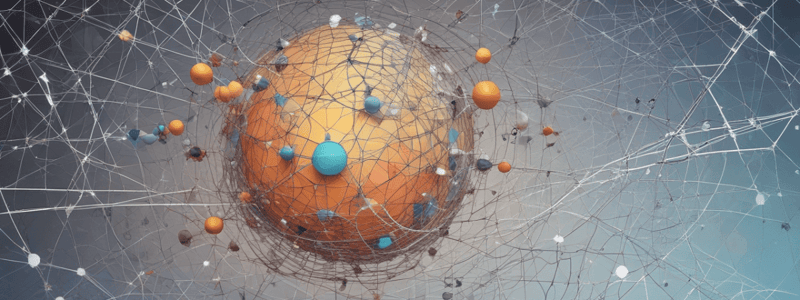Podcast
Questions and Answers
What is the primary focus of enterprise knowledge graphs?
What is the primary focus of enterprise knowledge graphs?
- To solve the Königsberg bridge problem
- To create relational databases
- To break down information silos and access information across an enterprise (correct)
- To advance graph theory
What is the key feature that distinguishes an enterprise knowledge graph from traditional graph theory?
What is the key feature that distinguishes an enterprise knowledge graph from traditional graph theory?
- Use of mathematical structures
- Representation of relationships between objects
- Use of relational databases
- Live links to actual instance data across the technology landscape (correct)
What problem did Leonhard Euler solve in the mid-18th century?
What problem did Leonhard Euler solve in the mid-18th century?
- The problem of relational databases
- The Königsberg bridge problem (correct)
- The problem of knowledge representation
- The problem of information silos
What is an example of instance data that might be connected to an enterprise knowledge graph?
What is an example of instance data that might be connected to an enterprise knowledge graph?
What is the primary role of an enterprise information architect?
What is the primary role of an enterprise information architect?
What is the relationship between graph theory and relational databases?
What is the relationship between graph theory and relational databases?
What is the primary advantage of using enterprise knowledge graphs?
What is the primary advantage of using enterprise knowledge graphs?
What is the key concept that underlies both graph theory and enterprise knowledge graphs?
What is the key concept that underlies both graph theory and enterprise knowledge graphs?
What is the primary purpose of the Enterprise Knowledge Graph (EKG)?
What is the primary purpose of the Enterprise Knowledge Graph (EKG)?
How does the EKG address the issue of data silos in organizations?
How does the EKG address the issue of data silos in organizations?
What is the significance of using a triple store in the context of an EKG?
What is the significance of using a triple store in the context of an EKG?
How does the EKG contribute to the concept of 'modern information architecture'?
How does the EKG contribute to the concept of 'modern information architecture'?
Why is human intelligence essential for building an effective EKG?
Why is human intelligence essential for building an effective EKG?
What is the primary difference between a relational database and a graph database?
What is the primary difference between a relational database and a graph database?
What is the role of 'ontology' in the construction of an EKG?
What is the role of 'ontology' in the construction of an EKG?
Why are EKGs not widely used in organizations today?
Why are EKGs not widely used in organizations today?
What is the most significant benefit of using an EKG for data analysis?
What is the most significant benefit of using an EKG for data analysis?
Which of the following is NOT a component of a triple in an ontology?
Which of the following is NOT a component of a triple in an ontology?
What are the three main components of a triple in a knowledge graph?
What are the three main components of a triple in a knowledge graph?
Which of the following describes the purpose of using controlled vocabularies in reference knowledge?
Which of the following describes the purpose of using controlled vocabularies in reference knowledge?
What is the Resource Description Framework (RDF) commonly used for?
What is the Resource Description Framework (RDF) commonly used for?
Which ontology is specifically mentioned as a standard for defining financial institutions?
Which ontology is specifically mentioned as a standard for defining financial institutions?
What are ontologies primarily used to define within a knowledge graph context?
What are ontologies primarily used to define within a knowledge graph context?
How does graph architecture benefit data integration compared to a relational database?
How does graph architecture benefit data integration compared to a relational database?
What does the acronym SKOS stand for?
What does the acronym SKOS stand for?
In the context of knowledge graphs, what is meant by 'master enterprise reference data'?
In the context of knowledge graphs, what is meant by 'master enterprise reference data'?
What is considered an initial building block necessary for a functional EKG?
What is considered an initial building block necessary for a functional EKG?
Which of the following correctly describes the relationship between types of things and specific things in the context of EKG?
Which of the following correctly describes the relationship between types of things and specific things in the context of EKG?
Which of the following scenarios is most likely to benefit from the implementation of an enterprise knowledge graph (EKG)?
Which of the following scenarios is most likely to benefit from the implementation of an enterprise knowledge graph (EKG)?
What is the primary reason why the author suggests starting small with use cases when implementing an enterprise knowledge graph?
What is the primary reason why the author suggests starting small with use cases when implementing an enterprise knowledge graph?
According to the content, what is the primary driver behind the need for data-centric approaches over application-centric approaches?
According to the content, what is the primary driver behind the need for data-centric approaches over application-centric approaches?
Which of the following statements best captures the author's perspective on the role of relational databases in the context of enterprise knowledge graphs?
Which of the following statements best captures the author's perspective on the role of relational databases in the context of enterprise knowledge graphs?
Based on the information provided, what is the most likely outcome of adopting a data-centric approach with enterprise knowledge graphs?
Based on the information provided, what is the most likely outcome of adopting a data-centric approach with enterprise knowledge graphs?
What is the key difference between a competency question and a business question in the context of enterprise knowledge graphs?
What is the key difference between a competency question and a business question in the context of enterprise knowledge graphs?
Flashcards are hidden until you start studying
Study Notes
Enterprise Knowledge Graphs
- Enterprise Knowledge Graphs (EKGs) represent a significant advancement in information architecture, enabling the breaking down of information silos and facilitating access and comprehension of information across an enterprise.
- EKGs combine business data with explicit representations of knowledge, including definitions of business objects found across the enterprise.
Graph Theory and Evolution
- Graph theory, dating back to the 18th century, is a way of using mathematical structures to model the relationships between objects.
- Advances in computing power have led to the development of modern graph theory practices, culminating in the birth of relational databases and application development.
Enterprise Knowledge Graph Components
- An EKG consists of two essential components: business data and an explicit representation of knowledge.
- The graph model directly links the connections between data, allowing organizations to analyze and understand relationships via actual data.
Concept of Relationships
- Relationships in the knowledge graph help break down information silos.
- Humans can manually find and determine relationships between data, but technology lacks the intelligence, context, and power of language to do so.
- Encoding relationships in the EKG makes them machine-readable, harnessing native intelligence and advanced computing power.
Modern Information Architecture
- Modern organizations face exponential increases in data, complicated technology landscapes, and dispersed business lines.
- EKGs help meet the requirements of seamless data connection, cross-functional analytics, and accurate results.
Triple-Stores and Graph DBs
- Graph databases, relying on triple-store technology, represent a different architecture than typical relational databases.
- Triple-stores are based on ontologies, where concepts or objects are described as triples (subject, predicate, and object) with permanent unique resource identifiers (URIs).
Building an EKG
- Initial building blocks for an EKG include reference knowledge, comprised of tools like controlled vocabularies and taxonomies.
- Standardized languages, such as SKOS and RDF, are used to express reference knowledge and ontologies.
- Conceptual knowledge is built using ontologies, and data is added to complete the EKG.
Accelerating into the EKG World
- Organizations can accelerate into the EKG world by using existing standards, such as FIBO and LEI, and starting with specific use cases.
- Use cases should involve constructing competency questions and determining if the knowledge graph is the best solution.
Conclusion
- EKGs offer a data-centric approach, shifting from application-centricity, to consolidate diverse data sources and break down information silos.
Studying That Suits You
Use AI to generate personalized quizzes and flashcards to suit your learning preferences.




